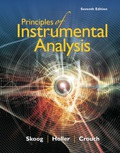
(a)
Interpretation:
The name of quantity and the way it is measured by TGA technique is to be described.
Concept introduction:
TGA is a technique which is defined as the thermal analysis method, in which the physical and chemical properties of the material are measured.
Answer to Problem 31.1QAP
Name of quantity = measurement of the mass of the analytes sample.
TGA technique works as a function of temperature.
Explanation of Solution
TGA technique is termed as thermogravimetric analysis. This technique is used for measurement of the mass of the analytes sample. This technique works as a function of temperature, which helps in the measurement of the quantity.
(b)
Interpretation:
The name of quantity and the way it is measured by DTA technique is to be described.
Concept introduction:
This technique is used to determine the temperature difference between the analyte sample and the reference with respect of time or temperature.
Answer to Problem 31.1QAP
Name of quantity = Measuring the gap between analyte the sample and the chemically stable inert reference.
DTA technique works as a function of temperature.
Explanation of Solution
The DTA is termed as differential thermal analysis. This technique is used for measurement of the gap between analyte sample and the chemically stable inert reference or blank. This technique works as a function of temperature which helps to perform the measurement.
(c)
Interpretation:
The name of quantity and the way it is measured by DSC technique is to be described.
Concept introduction:
The difference in the amount of heat is determined by using the DSC technique and this difference in heat is useful in increasing the temperature of the sample and the inert reference as a function of temperature.
Answer to Problem 31.1QAP
Name of quantity = Measurement of the heat difference between analyte sample and the inert reference.
This technique is used for the calculation of the heat difference.
Explanation of Solution
The DSC technique is also termed as differential scanning calorimetry. In this, the heat difference of analyte sample and the reference sample is measured. The heat difference is calculated with respect of temperature. The heat or energy is transferred to the reference sample in exothermic process while in endothermic process, the energy or heat is transferred to analyte sample.
(d)
Interpretation:
The name of quantity and the way it is measured by microthermal analysis technique is to be described.
Concept introduction:
The microthermal analysis technique is defined as the combination of the DSC technique with high spatial resolution of scanning probe microscopy.
Answer to Problem 31.1QAP
Name of quantity = the scanning of thermally sensitive probe which occurs on the surface of the sample.
The microthermal analysis technique works as a function of temperature and energy.
Explanation of Solution
In microthermal analysis, scanning of the thermally sensitive probe occurs on the surface of the sample. In this, the electric energy is used to maintain the temperature constant on probe which is measured and detected during the scanning process. The amount of energy required is less when the probe is near the region of the low thermal conductivity. Whereas, when probe is near to the region of high thermal conductivity, it requires high energy to maintain the temperature.
Want to see more full solutions like this?
Chapter 31 Solutions
Principles of Instrumental Analysis
- presented by Morallen Lig Intermine the hand product for the given mution by adding atoms, bonds, nonhonding diarion panda скуль Step 3: Comp the draw the product Step 2: Agama workup Compithe 429 ملولةarrow_forwardReaction A 0,0arrow_forwardpresented by Morillon Leaning Predict the organic product for the min кусур HSC Adithane carved arnown to come than that to the condon slchroruis in acid in in aquishri with ноюarrow_forward
- 6.15PM Sun Mar 30 K Draw the major product of this reaction. Include any relevant stereochemistry. Ignore inorganic byproducts. Problem 1 of O H [PhзPCH2CH3]*C|¯ NaH Drawing > Q Atoms, Bonds and Draw or tap a nearrow_forward8:17 PM Sun Mar 30 Draw the major product of this reaction. Ignore inorganic byproducts. HSCH2CH2CH2SH, BF3 Probler Drawing Ato Bonds Clarrow_forwardpresented by Mr L How the coprion. (Il Done in no wraction, dew the starting redential) доarrow_forward
- 8:16 PM Sun Mar 30 K Draw the major product of this reaction. Ignore inorganic byproducts. Proble 1. CH3MgBr 2. H3O+ F Drawingarrow_forwardо но оarrow_forwardName the major organic product of the following action of 4-chloro-4-methyl-1-pentanol in neutral pollution 10+ Now the product. The product has a molecular formula f b. In a singly hain, the starting, material again converts into a secule with the molecular kormula CIO. but with comply Draw the major organic structure inhalationarrow_forward
- Macmillan Learning Alcohols can be oxidized by chromic acid derivatives. One such reagent is pyridinium chlorochromate, (C,H,NH*)(CICTO3), commonly known as PCC. Draw the proposed (neutral) intermediate and the organic product in the oxidation of 1-butanol by PCC when carried out in an anhydrous solvent such as CH₂C₁₂. PCC Intermediate OH CH2Cl2 Draw the intermediate. Select Draw Templates More с H Cr о Product Draw the product. Erase Select Draw Templates More H о Erasearrow_forwardIf I have 1-bromopropene, to obtain compound A, I have to add NaOH and another compound. Indicate which compound that would be. A C6H5 CH3arrow_forwardProvide the reagents for the following reactions.arrow_forward
 Principles of Instrumental AnalysisChemistryISBN:9781305577213Author:Douglas A. Skoog, F. James Holler, Stanley R. CrouchPublisher:Cengage Learning
Principles of Instrumental AnalysisChemistryISBN:9781305577213Author:Douglas A. Skoog, F. James Holler, Stanley R. CrouchPublisher:Cengage Learning

